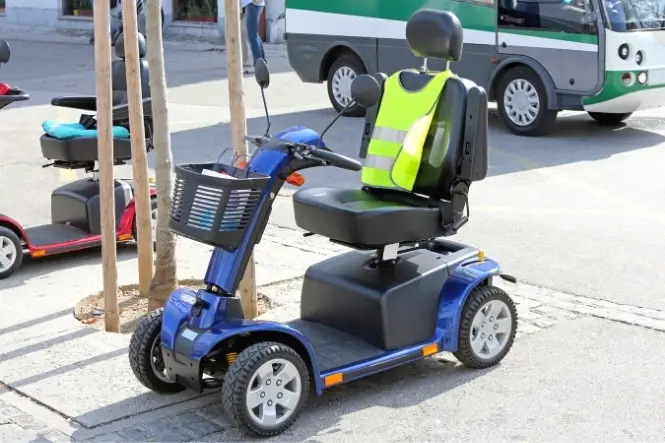Your mobility scooter is an incredibly important piece of equipment and for many people, is the difference between getting about and being stuck at home. So, when something goes wrong, it can be worrying and frustrating.
The good news is that there are several problems that can be easily fixed. Yes, there are those that require a little more know-how but if you’re able to troubleshoot effectively, you’ll be much more easily able to deal with the issues and get the right help.
In this guide, I’ll look at some of the most common mobility scooter problems and how to fix them. We’ll have you back on the road in no time!
Keep in mind that some of the problems you experience may be unique to your particular model. In this case, you’ll need to contact the manufacturer who will be able to provide you with more tailored advice.
Problems With The Battery
Perhaps the most common issues faced by mobility scooter users are those related to the battery. As you use a battery, it’ll naturally lose charging capacity over time and this translates into some potential problems.
Some of the things you might notice can include the battery not registering when it is connected to the charger or it may not give you as long a running time as it did when it was new. Some people notice that, when using older batteries, the mobility scooter may stop and start at random.
It’s totally normal for a battery to behave this way and when you first purchase a mobility scooter, you’ll likely be advised that replacement batteries will be part of the ongoing costs. This is because batteries are only able to go through so many cycles of charging and discharging before they are rendered useless.
Therefore, if you notice any of the things I have mentioned in relation to the battery, I’d consider replacing it with a new one.
But My Scooter Still Won’t Start
Now, if you’ve got a fully charged battery that’s not run its course but your mobility scooter is still refusing to start then it’s likely another issue.
For starters, it could be that the key is not in the scooter in which case, it’ll be a simple fix involving inserting the key and switching it into the ON position. In other cases, it could be that the key isn’t inserted properly so make sure that it’s fully in the slot and in the correct position.
Your mobility scooter will be fitted with a manual free-wheeling lever or switch and it’s important that this is in the OFF position before you can start your scooter. The reason for this switch is to enable the user to manually push their mobility scooter and when engaged, it’ll turn off the brakes and motor. But this also means that it’ll stop the scooter from firing up so check that it’s switched OFF.
You’ll also notice that mobility scooters have a power saving mode which may activate when you don’t want it to. This can prevent the scooter from starting so you will need to take out the key and give it around 30 to 60 seconds. After this, put the key back into the scooter and everything should work as normal. While this is a pain, the power save system is important as it’ll stop your battery from discharging when the scooter isn’t in use. In most cases, this feature will engage within five minutes of the scooter not moving.
Finally, if you’re still having problems getting your scooter up and running, it could be that you need to reset the circuit breaker. To do this, there’s a circuit breaker button that just needs to be pressed but do keep in mind that, on some models, it might be labelled with the word RESET
Problems With The Tyres
On a mobility scooter, there will either be solid or pneumatic tyres. Out of the two, it’s pneumatic tyres that are going to give you the most problems owing to the potential of them going flat. If you notice that the mobility scooter feels bumpy to ride or doesn’t handle as well as normal, this could indicate an issue with the tyres.
Moreover, when you have a flat or punctured tyre, you’ll likely notice that the performance of the brakes is reduced in which case, you’ll need to stop using the scooter and check the tyres. In the event of deflation, a puncture or any other issues, the only thing that’ll solve your problem is replacing the tyre.
Problems With The Potentiometer
The potentiometer, more commonly known as the throttle pot can cause problems with the speed of your mobility scooter if it is not functioning correctly. Most notable, you’ll find that the mobility scooter starts speeding up or slowing down for no apparent reason.
This part of the mobility scooter is what enables you to move forwards and backwards but because it’s often exposed to the elements, there is a risk of corrosion. When this happens, the throttle pot can stop working.
If you have a multimeter, you can use this to check the voltage. However, in the case that you need to replace the potentiometer, don’t worry, they’re not expensive parts and, provided you have a basic electrical knowledge, you should be able to fit them at home. Otherwise, just contact a repair person who will be able to get it done for you.
Problems With The Motor
Usually a mobility scooter motor won’t give you too many problems but as with anything, they will fail over time. In older scooters, you’ll find that the motor might drop its power output which can make the ride feel significantly bumpier. If this happens a lot then it’s a sign that the motor could be starting to fail and it’s worth getting it replaced.
However, this isn’t typically a job you’ll be able to do at home and it’s important to have the scooter worked on by a specialist. Not only will they ensure that the work is done properly but it’ll also give you peace of mind when you’re out and about.
Problems With The Ignition Switch
Another of the most common problems on mobility scooters is an issue with the ignition switch. The problem is that, just like the throttle pot, these parts are exposed to the elements so they take a lot of battering that can shorten their lifespan.
Where a lot of corrosion occurs, it’s even possible for the ignition key to break off completely. If this happens then you’ll need to grab a set of tweezers to pull it out and if this fails, step up your tool to some needle nosed pliers. These will allow you to turn the key even while it’s stuck in the scooter which means you can carry on using the scooter up until you get it fixed. Although, I’d advise doing this as soon as you can.
Scooter Is Running Slowly Even When At Full Throttle
If you have been pressing the throttle fully but your mobility scooter still runs slowly then this could be down to a number of issues.
First of all, it could be related to the battery which may simply need charging. Once the power starts to run low, the battery is unable to keep the scooter running as effectively. Just make sure that you always fully charge the batteries.
Moreover, you need to think about where you are trying to operate your scooter. If you’re using it on a slope then the scooter will be using most of its power to climb so speed will be decreased.
Finally, mobility scooters will only operate properly within a certain weight capacity. This limit will be detailed in your user manual as well as on the product listing online. While a lot of people consider the rider to be the only thing that adds to the weight limit, you have to think about additional equipment like bags, oxygen tanks and other things.
If the scooter is overloaded then it will struggle to get up to full speed. If you try to take it on an incline then its performance may dwindle even more and in some cases, the scooter may stop altogether. This is why it’s really important to choose a mobility scooter that’s compatible with your size and weight.
Circuit Breaker Keeps Tripping
If the mobility scooter circuit breaker is continually tripping then this is likely to be related to a battery issue. It could be the case that you aren’t charging your batteries often enough or that they’re simply getting old. In which case, you’ll need to refer to the tips I discussed earlier in this guide.
It is possible to have the batteries tested for load strength but you might just have to admit defeat and replace them.
Final Thoughts
Having a mobility scooter can seriously improve your quality of life but when things go wrong, you literally feel stuck and unable to go anywhere.
There is a degree of maintenance involved in owning one of these scooters including regular battery charging, ensuring the scooter isn’t overloaded and replacing the batteries in time. However, things can still go wrong and educating yourself on potential mobility scooter issues will ensure that you know just what to do when the moment calls for it.
While some things can be fixed as a DIY job, others require a professional touch so it’s important that you call for help when you aren’t sure what to do. The last thing you want is to damage the scooter even more.

